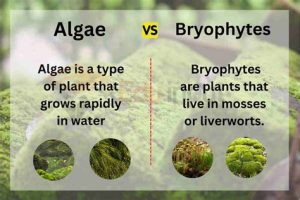1.4 | Lower Forms of Plant Life
Learning Objectives
-
SLO 1: Describe effects of plant science practices on ecosystems and society.
-
SLO 2: Explain effects of techniques and materials on plant growth, development, photosynthesis, and reproduction.
-
SLO 3: Locate and explain functions of plant cells, tissues, and organs.

1.4.1 Algae: Photosynthetic Protists & Green Algae
Algae encompass a diverse group of mostly photosynthetic organisms, ranging from unicellular diatoms to giant kelps. They inhabit aquatic and moist terrestrial environments. These organisms lack true roots, stems, or leaves but perform photosynthesis using chlorophyll and other pigments. In this sense, algae are the evolutionary precursors to land plants—sharing key traits like chloroplasts derived from ancient endosymbiosis SlideServe+4Biology LibreTexts+4Biology LibreTexts+4Biology LibreTexts.
Green algae (e.g., Spirogyra, Volvox) are especially significant because they belong to the supergroup Archaeplastida, the same lineage that gave rise to land plants. Their carbohydrate storage as starch and cellulose cell walls continue as foundational features in true plants Biology LibreTexts.
They are critical primary producers in aquatic ecosystems and contribute to carbon fixation globally, helping regulate atmospheric CO₂ – an essential ecosystem service.
Examples
Real‑World Example
Algal blooms in irrigation canals—while providing oxygen and food, they can also clog infrastructure, demonstrating the need to manage algal growth in agricultural water systems.
Questions to Ponder
-
How do green algae share structural and biochemical traits with land plants?
-
What ecological roles do algae play in freshwater and marine systems?
-
How might algal research inform biofuel or bioplastic development?
-
Why are chloroplast origin and endosymbiotic events critical in plant evolution?
Self‑Check Exercises
-
True/False: All photosynthetic eukaryotes form a single taxonomic group.
-
Short Answer: Name two evolutionary connections between green algae and land plants.
-
Diagram Labeling: Sketch a typical algal cell showing chloroplast, cell wall, and flagella (if present).
-
Calculation: Estimate oxygen released by 10 g of algal biomass (assume theoretical yield).
Suggested Images
-
Figure 1.1: Spirogyra filament with spiral chloroplasts.
-
Figure 1.2: Phylogenetic tree linking green algae and embryophytes.
1.4.2 Bryophytes: Non-Vascular Land Plants
Bryophytes—mosses, liverworts, and hornworts—are the earliest lineage of land plants that colonized terrestrial environments following algae
They lack lignified vascular tissues (xylem/phloem), true roots, and complex leaves, relying instead on rhizoids for anchorage and water absorption
A defining feature is their dominance of the gametophyte (haploid) generation and the production of sporophytes (diploid) directly on the gametophyte—often dependent on it Biology. Their thin form and requirement for water for sperm motility reflect the transitional adaptations from water to land.
Bryophytes play crucial ecological roles: they initiate soil formation on bare rock, retain moisture in ecosystems, indicate environmental quality, and provide habitats—linking tightly to Course Objective 4.
Examples
Real‑World Example
Peat moss (Sphagnum) forms bogs that sequester carbon and are used as planting medium—an intersection of ecology and horticulture.
Questions to Ponder
-
How does the bryophyte life cycle reflect evolutionary challenges of terrestrial life?
-
In what ways do bryophytes contribute to soil development and ecosystem water retention?
-
Why does gametophyte dominance matter in evolutionary terms?
-
How are bryophytes used commercially or in ecological monitoring?
Self‑Check Exercises
-
True/False: Bryophytes possess lignified xylem.
-
Short Answer: List the three bryophyte groups and one distinguishing trait each.
-
Lifecycle Diagram: Label bryophyte gametophyte and sporophyte structures.
-
Fill‑in–the–Blank: Rhizoids function primarily in _______ and _______.
Suggested Images
-
Figure 1.3: Cross section of a moss showing gametophyte and sporophyte.
-
Figure 1.4: Diagram comparing leaf anatomy in mosses vs. liverworts.
Summary
Lower plants like algae and bryophytes epitomize the early stages of plant evolution from aquatic photosynthetic protists to terrestrial land colonizers. Algae laid the biochemical and cellular foundations for later terrestrial success, while bryophytes pioneered the first true land plant forms—adapting to drier habitats via gametophyte dominance and non-vascular structures. Together, they illuminate the evolutionary and ecological progression critical to understanding higher plant forms and their technological applications.
Key Terms
-
Algae: Photosynthetic protists with no vascular structures.
-
Archaeplastida: Supergroup including land plants and green/red algae.
-
Bryophytes: Non-vascular land plants with dominant gametophyte stage.
-
Gametophyte: Haploid, gamete-producing stage in alternation of generations.
-
Sporophyte: Diploid, spore-producing stage.
-
Rhizoids: Root-like structures for anchorage and absorption in bryophytes.
-
Xylem/Phloem: Vascular tissues that bryophytes lack.
-
Lignin: Rigid polymer for structural support, absent in bryophytes.
Attributions
-
Adapted sections Algae and Bryophytes based on Bio LibreTexts — Botany (Ha, Morrow & Algiers) under CC BY-NC Slid
-
Images and lifecycle diagrams adapted with modification from LibreTexts and Britannica Biology LibreTexts
Media Attributions
- Algae vs bryophytes © Sonika Singh adapted by CareerPower / Sonika Singh is licensed under a CC BY-NC-SA (Attribution NonCommercial ShareAlike) license
Photosynthetic protists with no vascular structures.
Supergroup including land plants and green/red algae.
